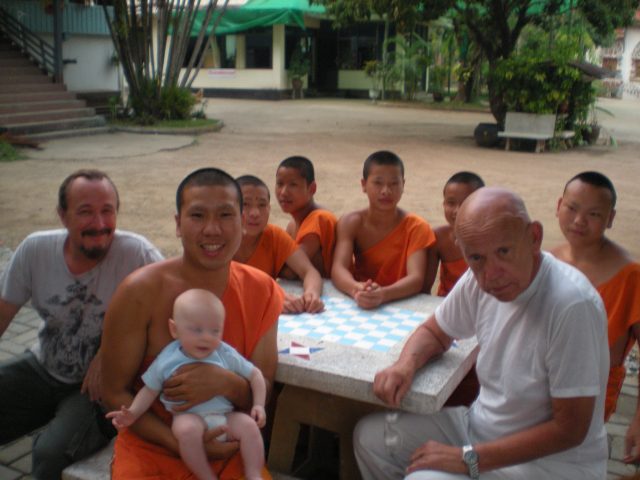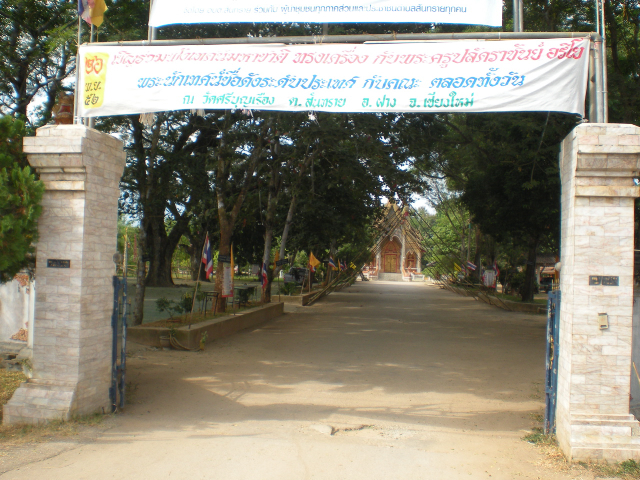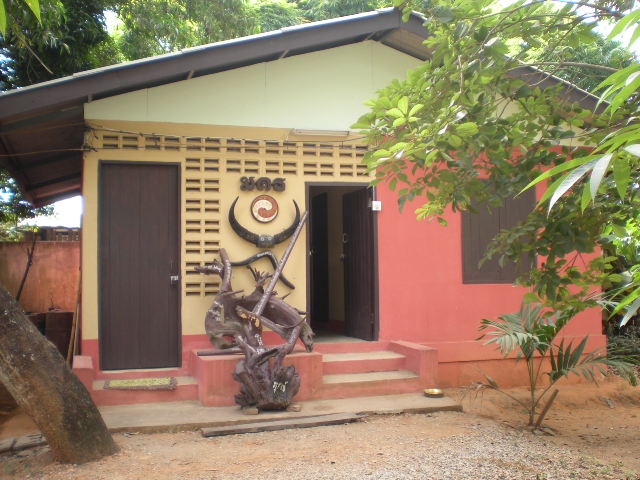In Chiang Mai, Thailand, there are tourist attractions for the would-be chef, masseuse, and now, monk. The recently started ‘Monk for a Month’ program is a new example of the mixing of religion and commerce. The program provides the opportunity to ordain, live in a Thai temple, and receive basic Buddhist teachings and meditation instruction. However, all of this is offered for a price depending on length of stay and intended ordination status.
The program takes place in Wat Sri Boen Ruang in Fang, Chiang Mai. When I went for a visit, a few novice monks greeted me in English, asking where I came from. Obviously the interaction with foreigners through this program has given these novices confidence with their English-speaking abilities. Wat Sri Boen Ruang has about 50 novices in residence and about 100 novices that attend the school on the monastery grounds, but only a handful of fully ordained monks. Thus the main interaction of the foreign participants is with novices–they go on their alms round together and can often be seen sitting and chatting in English.
Despite the Monk for a Month hype on the internet (see, for instance, the Thai Visa Forum discussion) and the popular Facebook fan page, there is nothing to indicate this temple hosts the program. There are no signs, and not many foreigners can be seen. There are usually between 1-4 participants in the program with only a few rooms available for the guests.
This program began about a year and a half ago, with the permission of the abbot of Wat Sri Boen Ruang. The abbot, Phra Aphisit Pingchaiyawat, aged 37 with a Ph.D. from India, has a vision to build a large international meditation center. Monk for a Month is a stepping stone toward this larger goal. Ben Bowler, founder of the program, has been living in Fang for three years. He was volunteering in the Shan State in Burma for a year and decided to stay in northern Thailand. Bowler and his wife were already running English language lessons here so the Monk for a Month program grew out of this organically. Bowler and Phra Aphisit have aligned objectives and this program would not have been possible under different circumstances.
During my visits to this site, I noticed that the interactions between the staff, novices, and participants has the feeling of a close-knit community. The participants ask the staff any casual questions they have, eat lunch together, and chat about upcoming activities and other Buddhist meditation opportunities in the area.
Perhaps because of this atmosphere none of the participants so far has complained about having to pay to participate in the program. Bowler decided to make this a commercial enterprise because he had upfront costs like staff wages and advertising, mostly facebook ads that helped to promote their fan page. The fixed price helps Bowler have some security. He would consider moving to a donation-based system but this would be a leap of faith, as it would be hard to know if the participants would give enough to keep the program running. Some past participants have not been able to pay the full price and Bowler and staff have been able to work out something for them, and so far have not had to turn anyone away. Bowler uses the extra money from the program to support his real passion, the Blood Foundation, which helps to further his volunteer work in the Shan State.
From my conversations with Bowler, he indicated that there are various purposes to Monk for a Month, which he calls a cultural exchange program. Bowler hopes the program will help participants get a full picture of the Buddhist tradition, support and understand issues of social justice and pluralism, and take with them the experiences of ordination, meditation, and interactions with the novices.
Bowler knew that teaching about Buddhism had to be a part of this program as he intended it to be for spiritual seekers. Essentially, Bowler finds Monk for a Month couldn’t operate without a teacher. To this end, Bowler found Dhamma Instructor, Fred Blandford, a resident of Fang, by chance while eating lunch one day. Blandford’s qualifications are that he has been a Buddhist for over 30 years, has been to many retreats at Wat Rampoeng, Chiang Mai, and elsewhere, has read many books on Buddhism, and has learned from a number of Thai teachers. Participants receive seven days of two-hour sessions with Blandford beginning with basic teachings on Thai culture, basics of Buddhism, and how to behave in a temple. Over the next few days students learn about the Buddha’s life story, the basics of concentration and vipassana meditation, major Buddhist concepts, and points of Buddhist morality. The seven days of teaching are rounded out with a discussion of the four stages of Enlightenment and Buddhist cosmology. So participants get a full dose of the religion of Buddhism from Blandford. Bowler applauds this approach because he finds that in the West most people have an idealized view of Buddhism–only hearing about its rational and scientific nature, but nothing about cosmology or ritual. With Blandford’s teaching participants end up with a more rounded idea of the tradition.
Besides learning the basics of Buddhism from Blandford, Bowler also hopes that the participants come away with a sense of social justice and is thus very much in favor of the movement of socially engaged Buddhism. Although he feels these are important to each religious tradition, this aspect doesn’t contribute to social justice. The main message Bowler tries to convey through this program is that one cannot divorce one’s own spiritual development from service and social justice. The participants get a taste of this social engagement while practicing English with the novices at the temple and through trips to the Shan states that Bowler organizes for the participants.
Another objective of this program is to support and encourage the growing pluralism among the world’s religions. From Bowler’s point of view, the program is not about becoming a Buddhist but rather incorporating ideas from various traditions into one’s daily life. This is at the heart of the program because Bowler created this not for committed Buddhists but seekers with an interest in Buddhism.
The last main purpose of this cultural exchange program is to offer an authentic view of the monastic life. The program has hosted roughly 100 participants, 70 of them men. Of these 70, 30-40 have become novices who have taken the ordination seriously. The participants ordain in the same ceremony as the Thai novices, study the 10 precepts and make a showing of commitment by memorizing some of the Pali ordination chanting. But Bowler admits that the preparation is not extensive, as the program takes a ‘learn as you go’ approach. The foreign monastics perform the duties of a novice by participating in ceremonies, such as funeral and community events, and going for alms every morning, and the local community has received them well.
Thus the Monk for a Month program is another unique offering for tourists in the Chiang Mai region. Participants of this program are given the chance to ordain, learn about Buddhism, and contribute to Bowler’s vision of social justice and pluralism in the modern world. Some outsiders are critical of the program because of the issue of mixing religion and commerce, but Bowler finds that what is most interesting about the program is the cultural exchange aspect and the support of social engagement and inter-faith dialogue.
Brooke Schedneck is a Ph.D. candidate at Arizona State University. She owns the Wandering Dhamma blog.
 Facebook
Facebook  Twitter
Twitter  Soundcloud
Soundcloud  Youtube
Youtube  Rss
Rss 


